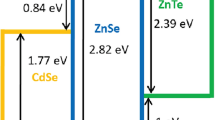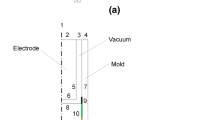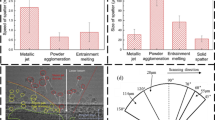Abstract
In plasma spraying, the particle velocity at the injector outlet has significant influence on the particles’ penetration into the plasma jet. The geometry of the injector and the flow rate of the carrier gas determine the particle velocities. Based on numerical simulations, it is evident that higher particle velocities and thus, a deeper penetration of the particles into the plasma jet, can be realized with an injector geometry which is significantly longer than the standard injector. This results in a higher melting degree of the particles, especially for operating parameters leading to high-speed plasma jets. In order to verify the results of the simulations, injectors with different diameters and lengths were manufactured and their influence on the particle velocities at the injector outlet was measured via particle diagnostics. The injectors were furthermore used to apply alumina coatings with a multi-cathode plasma generator. The resulting coating thicknesses were determined. Based on these results, it seems feasible to influence the injection behavior of the particles positively by increasing the injector length. By comparing the relative intensities of the α- and γ-alumina peaks in the XRD patterns, it is shown that these changes in injector geometry did not affect the phase composition.












Similar content being viewed by others
Abbreviations
- C D :
-
Drag coefficient
- d inj :
-
Diameter of the injector head
- d p :
-
Particle diameter
- e :
-
Coefficient of restitution
- I:
-
Electric current
- l inj :
-
Length of the injector head
- \(\dot{m}_{\text{p}}\) :
-
Powder feed rate
- µ g :
-
Dynamic viscosity of the carrier gas
- Rep :
-
Reynolds number of the particles
- ρ g :
-
Density of the carrier gas
- ρ p :
-
Density of the particles
- s :
-
Coating thickness
- σ p :
-
Standard deviation of the particles’ size distribution
- T inlet :
-
Gas temperature at the injector inlet
- v g :
-
Gas velocity
- v p :
-
Particle velocity
- \(\dot{V}\) :
-
Plasma gas flow rate
- \(\dot{V}_{\text{inj}}\) :
-
Carrier gas flow rate
- XRD:
-
X-Ray diffraction
References
M. Vardelle, A. Vardelle, P.L. Fauchais, K.-I. Li, B. Dussoubs, and N.J. Themelis, Controlling Particle Injection in Plasma Spraying, J. Therm. Spray Technol., 2001, 10(2), p 267-284
V. Srinivasan, M. Friis, A. Vaidya, T. Streibl, and S. Sampath, Particle Injection in Direct Current Air Plasma Spray: Salient Observations and Optimization Strategies, Plasma Chem. Plasma Process., 2007, 27(5), p 609-623
R.C. Tucker, Ed., Thermal Spray Technology, 2nd ed., ASM International, 2013
L. Pawłowski, The Science and Engineering of Thermal Spray Coatings, 2nd ed., Wiley, 2008
M. Vardelle, A. Vardelle, P. Fanchais, and I. Saray, Comparison of Classical and Axial Injection Torches For Spraying Alumina Coatings, Mater. Manuf. Processes, 1994, 9(4), p 735-755
K. Bobzin and M. Öte, Modeling Multi-Arc Spraying Systems, J. Therm. Spray Technol., 2016, 25(5), p 920-932
K. Bobzin, M. Öte, J. Schein, S. Zimmermann, K. Möhwald, and C. Lummer, Modelling the Plasma Jet in Multi-Arc Plasma Spraying, J. Therm. Spray Technol., 2016, 25(6), p 1111-1126
M. Öte, Understanding multi-arc plasma spraying, Dissertation, Shaker Verlag GmbH, RWTH Aachen, 2016
R. Westhoff, G. Trapaga, and J. Szekely, Plasma-Particle Interactions in Plasma Spraying Systems, MTB, 1992, 23(6), p 683-693
L. Pawłowski, Optimization of Arc Plasma Spraying Parameters, Surface Technology, 1980, 11, p 8-16
M. Vardelle, A. Vardelle, P. Fauchais, and M.I. Boulos, Plasma—Particle Momentum and Heat Transfer: Modelling and Measurements, AIChE J., 1983, 29(2), p 236-243
T. Zhang, D.T. Gawne, and B. Liu, Computer Modelling of the Influence of Process Parameters on the Heating and Acceleration of Particles During Plasma Spraying, Surf. Coat. Technol., 2000, 132(2-3), p 233-243
J. Larjo, E. Hamalainen, and N. Kriikka, In-Flight Particle Imaging in Thermal Spraying With Diode Laser Illumination, Thermal Spray 2003: Advancing the Science and Applying the Technology; 5 - 8 May 2003, Orlando, Florida, Usa; Proceedings of the International Thermal Spray Conference, Itsc 2003, 1st ed., B.R. Marple and C. Moreau, Eds., ASM International, 2003, p 1113-1116
J.F. Bisson, C. Moreau, M. Dorfman, C. Dambra, and J. Mallon, Influence of Hydrogen on the Microstructure of Plasma-Sprayed Yttria-Stabilized Zirconia Coatings, J. Therm. Spray Technol., 2005, 14(1), p 85-90
K. Seemann, A. Fischer, and E. Lugscheider, Influence of Noise Factors at Atmospheric Plasma Spraying, International Thermal Spray Conference: Conference Proceedings, E. Lugscheider, Ed., 4 - 6 March 2002 (Essen), Verl. für Schweißen und Verwandte Verfahren DVS-Verl., 2002, p 1007-1010
J.R. Davis, Ed., Handbook of Thermal Spray Technology, 1st ed., ASM International, 2004
R. McPherson, Formation of Metastable Phases in Flame- and Plasma-Prepared Alumina, J. Mater. Sci., 1973, 8(6), p 851-858
R. McPherson, On the Formation of Thermally Sprayed Alumina Coatings, J. Mater. Sci., 1980, 15(12), p 3141-3149
R.B. Heimann, Plasma Spray Coating: Principles and applications, 2nd ed., Wiley-VCH, 2008
R. McPherson, A Review of Microstructure and Properties of Plasma Sprayed Ceramic Coatings, Surf. Coat. Technol., 1989, 39-40, p 173-181
N.N. Ault, Characteristics of Refractory Oxide Coatings Produced By Flame-Spraying, J American Ceramic Society, 1957, 40(3), p 69-74
Acknowledgments
The presented investigations were carried out at RWTH Aachen University within the framework of the Collaborative Research Centre SFB1120-236616214 “Bauteilpräzision durch Beherrschung von Schmelze und Erstarrung in Produktionsprozessen” and funded by the Deutsche Forschungsgemeinschaft e.V. (DFG, German Research Foundation). The sponsorship and support is gratefully acknowledged. Simulations were performed with computing resources granted by RWTH Aachen University under project rwth0315. The authors would like the thank Jannis Künzer and Dirk Ortmanns for their efforts in manufacturing the injector heads.
Author information
Authors and Affiliations
Corresponding author
Additional information
Publisher's Note
Springer Nature remains neutral with regard to jurisdictional claims in published maps and institutional affiliations.
Electronic supplementary material
Below is the link to the electronic supplementary material.
Supplementary material 1 (MP4 685 kb)
Supplementary material 2 (MP4 1022 kb)
Rights and permissions
About this article
Cite this article
Bobzin, K., Öte, M., Knoch, M.A. et al. Influence of the Injector Head Geometry on the Particle Injection in Plasma Spraying. J Therm Spray Tech 29, 534–545 (2020). https://doi.org/10.1007/s11666-020-01009-6
Received:
Revised:
Published:
Issue Date:
DOI: https://doi.org/10.1007/s11666-020-01009-6




